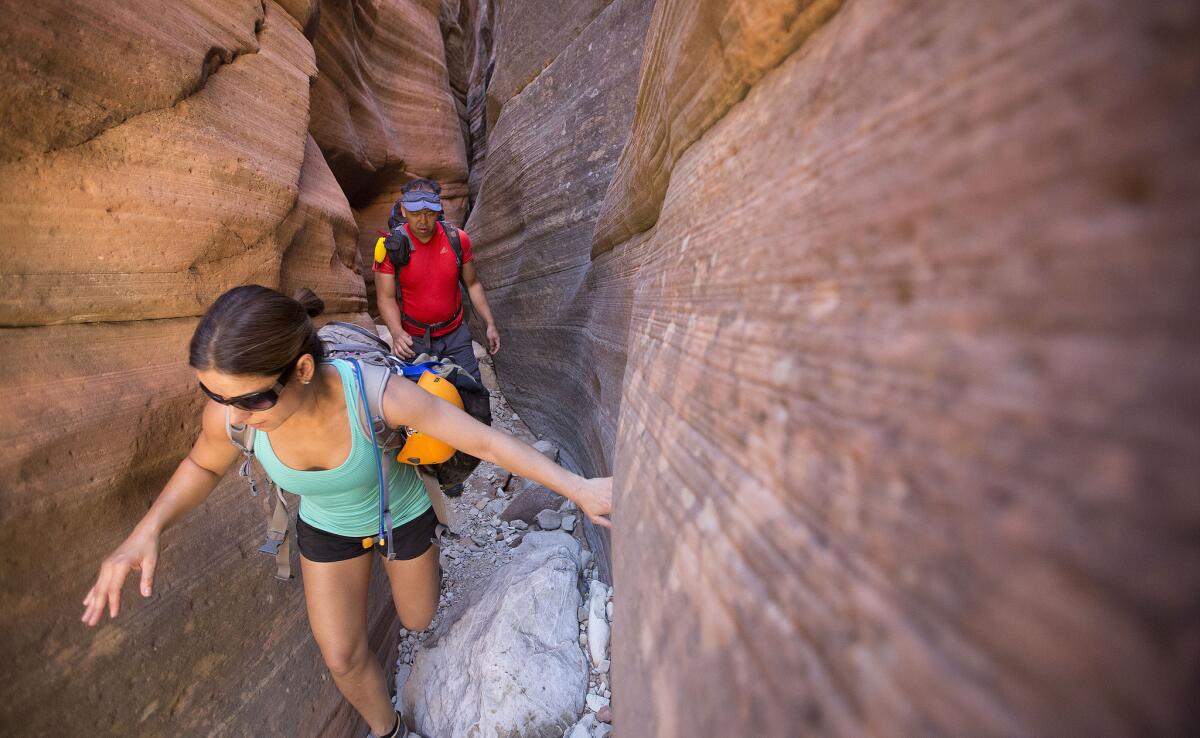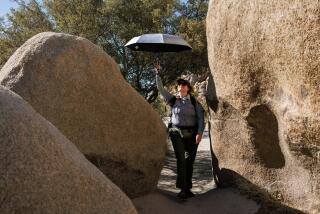The sensual beauty of Zion’s dangerous canyons

Ray Regalado and Marcela Prado explore Keyhole Canyon in Zion National Park, Utah, on Sept. 19, 2015. Days earlier, seven canyoneers there were swept away to their deaths by a flash flood.
Terry Tempest Williams is a conservationist, author and Utah native who spent her childhood summers in Zion National Park. She has written extensively about the Southwest and has served on the governing council of the Wilderness Society. After a flash flood Sept. 14 killed seven canyoneers in Zion’s Keyhole Canyon, Williams discussed the beauty and danger of nature, respect for the environment and whether regulation could make wild places any safer for the people who venture into them.
What do people see when they tackle a place like Zion with just ropes and their own feet? What vistas are accessible that they can’t see any other way?
Canyoneering is the inverse of mountaineering. It is a descent into the inner world. The vista that is accessible is being at the bottom of a canyon looking up through a slit of sky, some canyons so narrow you have to turn sideways to get through, others the width of outstretched arms with palms flat on either side.
Tell me about the slot canyons and how singular they are to a place like Zion.
The Zion Narrows is a place unlike any other. You feel like you are walking inside a dream, a sandstone labyrinth, sinuous and sensual. Red rock walls rise upward like praying hands. You have entered sacred space.
But it is not without fear. There are places where your choices are severely limited. Your only choice is to walk in water, the Virgin River, and if a flash flood comes there is no place to retreat. You can’t seek the shelter of hillsides above the river’s banks because there are no banks, only sandstone walls thousands of feet high on either side of the river, some years, only 20 feet across. If caught in a flash flood you will be flushed down-canyon without a thought or a chance of survival. The roar and rush of boulders cascading down a canyon led by a wall of water is a terrifying sight.
What is the impact of a sport like canyoneering? Do those ropes and bolts and feet cause too much damage?
All recreation has an impact on the land, be it off-road vehicles, mountain bikes or footprints.
Canyoneering is a low-impact “sport.” It’s more about ethics. One tries to leave no trace behind. But often, someone might leave a sling at the rappel point, or maybe some bolts used for rappelling will remain. But I think most people take pride in leaving the canyon as they found it — wild and, for the most part, pristine.
More people creates more impact. And today, canyoneering is attracting more people attracted to the adrenaline rush and adventure than the experience of wildness itself, and seeing beautiful country.
Should there be more regulation to protect the park and the people who want to see it?
When you enter into wild country, you enter at your own risk. That is part of its power. It’s also what separates experience from entertainment.
You can’t regulate the weather. You can’t regulate against a falling rock. There are risks involved. You also can’t regulate against stupidity. If you are canyoneering, you need to check the weather. But sometimes, you get caught in unexpected circumstances. It’s not that you’ve done anything wrong, it’s just that nature is more powerful and often unpredictable.
If we try to take all the risk out of our national parks and reduce them to playgrounds and museums, we no longer meet the landscape on its own terms, which is its power. And if our national parks become playgrounds and museums, no longer the dynamic places they are — subject to rock slides, flash floods, forest fires and encounters with wild animals — we have not only violated the rights of other species whose survival depends on these natural processes, we have destroyed the character, vision and grandeur of our nation’s wild lands.
I am so sorry for the loss of the families whose loved ones were drowned in the recent flash floods in Zion.... They will be remembered as we all remember life is fragile and precious. The land will always survive us.
Have you hiked or climbed or canyoneered that region?
I have — many times — hiked, climbed and canyoneered various canyons in Zion and southern Utah. As a child, we visited Zion National Park each year. It was our backyard. Whether it was the trail to Weeping Rock or the path to the Emerald Pools or the steep ascent up Angel’s Landing, Zion was home.
The Narrows can be devastating in its heat and brutal when it is cold. You might walk in freezing water much of the time, sometimes up to your waist. Each time is different. Each time you feel vulnerable in the presence of the winnowing light and exalted when you are done. It is one of my favorite hikes in Utah. But you never hike the Zion Narrows casually. It requires all your attention and all your strength.
Have you ever run into trouble while hiking in this place that you love?
I experienced two flash floods while hiking in the canyons of southern Utah around Cedar Mesa. Once when we were backpacking in Dark Canyon outside Canyonlands National Park, we were two days into our trip. It was a beautiful day with blue skies above. Suddenly, as we were walking in a dry streambed in a small canyon, small frogs started jumping onto our legs, attaching themselves to our pants and socks. It was very strange. Then, this strong smell of detritus or damp leaves reached us, wafting in the air.
We thought we could hear something up-canyon, and sensing it could be a flash flood, we sought higher ground, which was luckily available. Within minutes, a raging red river roared through the canyon carrying with it boulders the size of cars, uprooted cottonwood trees and everything in between. Had we not had higher ground to run to, we would have been flushed down-canyon and drowned.
Twitter: @marialaganga
More to Read
Sign up for Essential California
The most important California stories and recommendations in your inbox every morning.
You may occasionally receive promotional content from the Los Angeles Times.











